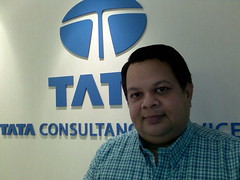 Image via CrunchBase
Image via CrunchBase
I mean if 1011 is the i/p then o/p=1101
Time copmlexity should be as small as possible...
2)Given 10 points, arrange those 10 points such that they make five straight lines and each straight line should
have 4-points
3) write Open Hashing code with doubly linked list
4)write linked list reversal program
5)Given an Array of integers as the input asked me to find out smallest subset of the array such that the sum of the all the elements
of that subset array should be maximum...in all the subsets...
6)To Give design aspects of writting a software for a car which will be driven by the blind people.
7)Given a character array which has one word asked me to reverse that word.
8)Given a character array which has "x" no of words, asked me to reverse them
9)A Desert has 1000KM legnth, A Camel and 3000 bananas are there at one end
problem is you have to get as many bananas as possible to the other end
by that camel.
camel constraints...
i) It will eat 1 banana for each kilometer even if it is not carrying any bananas(i.e it needs on banana
for just to walk 1km)
ii) It cannot carry more than 1000 bananas.
10) Given a two dimensional array of size mxn, Problem is to take each and every cell, as there are 8 directions to travel from that cell one right, two left, three up, four down, other four are through
four diagnols. except at the boundaries(<> print all ths words.
write all the different test cases for the above....
11) One function which was written by somebody else? that function spec
says the following.
takes a two dimensional array as the input which has "N" no of words
and "M" no of non-words...
that function returns the no of words.
given two cases of inputs...
1) array has 32words and 32 non words]
2) array has 30 wrods and 34 non words
out of these two which case is better and why?
12) Given the Robo which has PC interface via the following 3 functions
1) bool is_ther_any_step(bool);
sees any step above if the argument is true and returns true
if step exists above ti it.
sees any step below to it if the argument is false and returns
appropriately..
2) goto_next_step(bool )
Goes to next upper step if the argument is true
if the argument is true and no above step then robo gets damaged
Goes to down step if the argument is false...
3) Clean_floor()...
cleans that step by pouring water,cleaning and drying..
write the program to clean a stair case in any building...
![Reblog this post [with Zemanta]](http://img.zemanta.com/reblog_a.png?x-id=d6016b6d-07f9-4cf0-b89c-baf3c7bdbc3f)

![Reblog this post [with Zemanta]](http://img.zemanta.com/reblog_a.png?x-id=d0fe08df-2d52-4d44-8894-e5c25da49d3b)
![Reblog this post [with Zemanta]](http://img.zemanta.com/reblog_e.png?x-id=62d2840a-0fab-4fa6-bf33-506623ceaa90)
![Reblog this post [with Zemanta]](http://img.zemanta.com/reblog_a.png?x-id=95549a86-e145-4b18-9efa-ca9ea83d3be4)

![Reblog this post [with Zemanta]](http://img.zemanta.com/reblog_e.png?x-id=38975a48-53d1-42a9-9ca1-9f28ee6c6139)